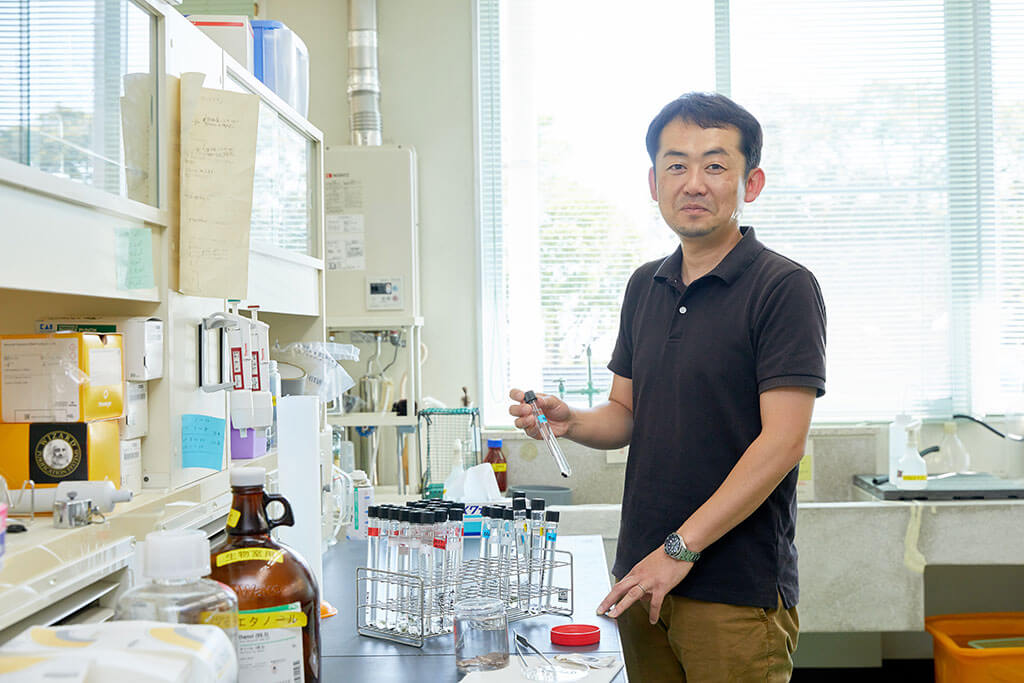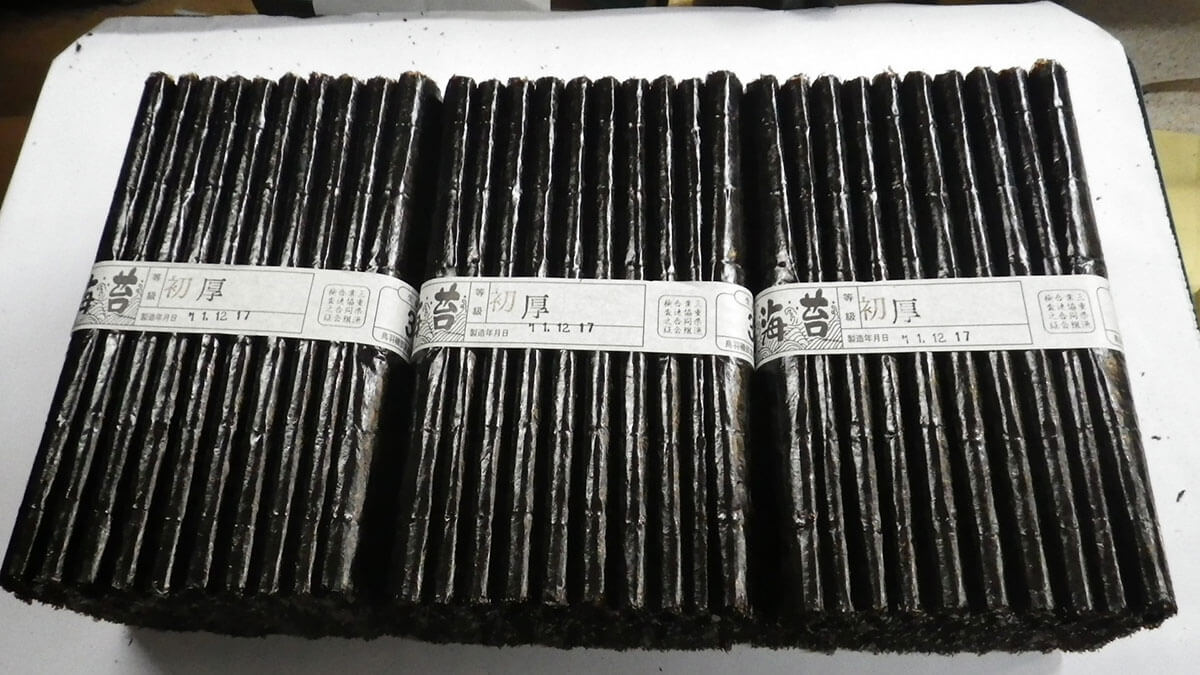“Mienoakari,” a black laver variety to resistant to a seawater temperature of 24℃

Farming of kuro-nori, black laver, is one of the key fisheries industries in Mie Prefecture and its production amounts to 2 billion yen. Black laver is farmed from October to March the next year. Recently, due to global warming, the seawater temperature does not fall very much as before in October when the farming is started. If black laver is started before the water temperature falls below 23℃, the laver may grow slowly and the yield will be affected. In 2005, Mie Prefecture began to work on the development of a variety adaptable to high seawater temperatures at the start of farming and developed “Mienoakari,” a variety resistant to high water temperature, in 2010. We interviewed Shoei Iwade, Chief Researcher at the Suzuka Fisheries Lab, the Mie Prefecture Fisheries Research Institute.
High water temperatures affect black laver yields within the year.
How are the high water temperatures at the start of farming affecting black laver farming?
Black laver farming begins in early October when the seawater temperature falls below 23℃. Recently, there are delays in the seawater temperature falling below 23℃ in October (Figures 1 and 2). The temperature sometime stays around 23℃ or it falls once and goes up again. It is getting harder to decide on when to start farming. If the start of farming is delayed, the farming period is shortened and the yield is reduced.
Black laver farming begins with stretching a net with laver seeds (conchospores) planted on the sea for seedling rearing. Seedling rearing is to grow healthy seedlings from the seeds. It is an important stage of the black laver farming process. Black laver grows as the seawater temperature falls. Due to high water temperatures in an early stage of the farming, in some cases, the thalli do not grow properly and that affect the subsequent stages of farming.

Figure 1: Water temperatures during seedling rearing in the past 30 years

Figure 2: The start date of seed planting in the sea in the Suzuka area
In Mie Prefecture, harvesting of laver begins in early December. Nori products made from laver harvested within the year are generally soft and high in quality and they are traded at a high price (Figure 3). The producers’ incomes greatly depend on how much they can produce yields while the laver can fetch a high price. It is necessary to start farming as early as possible. Mie Prefecture started research to develop a laver variety resistant to high water temperatures in FY 2005.

Figure 3: Production time and unit price (FY 2017)
Provided by the Mie Prefectural Federation of Fisheries Cooperatives
How did you develop the high-water-temperature resistant variety “Mienoakari”?
We used a method called “selective breeding” to select laver cells resistant to high water temperatures. We gathered about 1,000 laver thalli from fishery areas, cultured them with exerting stress of 25℃ or more and chose the cells that survived. We repeated the culture tests at higher water temperatures and selected thalli growing well and finally created “Mienoakari.” It took us three years to select a superior variety and five years in total including on-site verification tests.


How did you conduct the tests on site?
We conducted the tests in fisheries in Kuwana City, Suzuka City, Matsusaka City, Ise City and Toba City along the Ise Bay coast with the cooperation of 20 fisheries entities. We used both farming techniques; the “fixed net system” to hang laver nets between poles erected in shallow waters and the “floating system” to let the nets float on the surface of the sea.
The test results showed that, compared with the conventional varieties used for farming, the selected variety grew well at high water temperatures and that the incidence of morphological defects including multi-layered thalli was low. In average unit price and taste, the products made of the new variety were comparable to the conventional products. After repeating various tests, it was confirmed that the selected variety had resistance to high water temperature. In 2010, the variety was registered with the national government for the first time as an aquatic plant of Mie Prefecture.

Black laver farming based on the local fishery environment
How do you communicate with producers?
The number of laver farming entities in the prefecture was reduced from 800 to 101 in the past 30 years. In such an unfavorable environment, it is essential for all those concerned to share information and improve their awareness. Our institute organizes a workshop for all the producers in Mie Prefecture before the farming season starts in cooperation with the federation of fisheries cooperatives and other relevant agencies. In the workshop, we provide the latest information on the national production and farming technologies and exchange opinions about measures for the coming farming season. In addition to the workshop, we regularly visit the farms to establish a relationship with producers that makes it easy for them to talk about their problems or requests. To respond to the recent extreme weather and climate change, the producers themselves should deepen their understanding on the environment change and take action. Now, many producers check trends of seawater temperatures in early October before they start farming. As we have conducted the verification tests of “Mienoakari” in cooperation with producers, I believe they are quite aware of laver varieties.
To adapt to climate change, it is very important for not only researchers but also producers to make efforts. How is the new variety received by the producers actually farming “Mienoakari”?
When it had just been developed, “Mienoakari” was used as one of the varieties produced at almost all the fisheries in the prefecture. “Mienoakari” was well received by the farmers producing it. They said it was resistant to high water temperatures and it grew steadily. Several years later, we noticed a clear difference in the usage of “Mienoakari” among the fisheries. Black laver fisheries extend in the north-south direction in Mie Prefecture. They widely vary in the farming environment, for instance, greatly differing in salt or nutritive salt concentration. A rise in water temperature is a common problem to all the producers but, we leaned, they need a variety suitable for the environment of each fishery area. In the future new variety development, we must grasp the characteristics of individual fisheries.

I see the characteristics of sea conditions vary from area to area. I have heard there is a problem of discoloration besides high water temperature.
Besides high water temperature, laver discoloration is a serious problem. If we have little rain as in FY 2018, the river flow is reduced and nutrients in the sea are decreased. If phytoplankton proliferate rapidly and eat precious nutrients in the sea, nutrients necessary for pigment formation of laver, such as nitrogen and phosphorous, decline and discoloration results. Significantly discolored laver deteriorates in taste and the commercial value is drastically reduced. We have to seek traits that can reduce discoloration.

Creating a bright future for the black laver industry
Please talk about the latest trend in black laver farming.
Black laver producers do both gathering laver on the sea and processing them into sheets of dried seaweed using a large dryer for themselves. As gathered laver need to be processed within the day, the producers have to work from early morning to midnight. That is hard work. Processing is increasingly outsourced in Toba and other areas. The whole set of processing machines cost tens of millions of yen. As processing is outsourced, the producers can save money on investment in equipment. Their labor hours are also reduced and their work style is changing. One producer says, “I used to be working from morning to night at the farm during the season. As we outsource the processing work, I can be home and spend time with family at seven in the evening.” I hope we can help solve problems of the black laver industry, including a shortage of successors, by promoting new ideas like that.

What do you find it rewarding to work for black laver farming in Mie Prefecture? Please also tell me future outlooks.
I myself started research on black laver 10 years ago. I was temporarily transferred to another section. This year I am back to be engaged in the field of black laver again. A producer I’ve known for a long time tells me, “Develop another good variety while I am still active.” Such a relationship with producers enhances my motivation.
The high-water-temperature resistant is named “Mienoakari” in the hope of a bright future of the black laver industry of Mie Prefecture. I hope “Mienoakari” will contribute to black laver farming in Mie Prefecture as the name suggests.
I want many people to know that quality laver really tastes great. Laver is highly nutritious food rich in high-quality protein, calcium and vitamins. We would like to continue to show the appeal of black laver with the collective effort of the industry.

(Posted on September 4, 2019)
References

